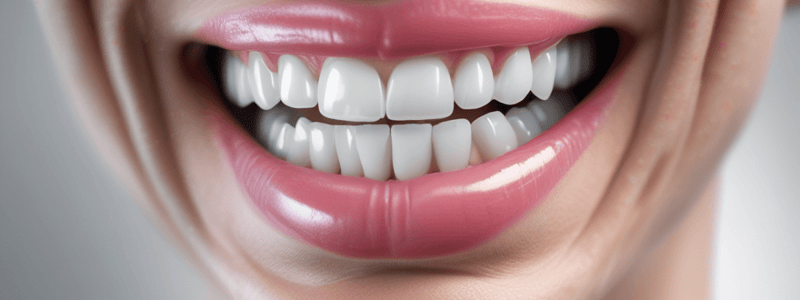Podcast
Questions and Answers
What is the primary advantage of the open-tray technique in implant impressions?
What is the primary advantage of the open-tray technique in implant impressions?
- It eliminates the need for x-ray confirmation of transfer seating
- It enables extra-oral abutment selection in the lab
- It reduces the effect of implant angulation and deformation of impression material (correct)
- It allows for the fabrication of custom abutments
What is the purpose of the transfer coping in the open-tray technique?
What is the purpose of the transfer coping in the open-tray technique?
- To provide retention for the impression material
- To transfer the impression to the master cast (correct)
- To act as a locator for the implant analog
- To create a snap-on impression cap
What type of abutment selection is facilitated by the implant-level impression technique?
What type of abutment selection is facilitated by the implant-level impression technique?
- Extra-oral abutment selection in the lab (correct)
- Custom abutment fabrication using UCLA abutment
- Intra-oral abutment selection during impression taking
- Abutment selection based on x-ray confirmation of transfer seating
What is the main difference between the open-tray and closed-tray techniques in implant impressions?
What is the main difference between the open-tray and closed-tray techniques in implant impressions?
What is the purpose of the implant analog in the impression technique?
What is the purpose of the implant analog in the impression technique?
What is the primary advantage of the abutment-level impression technique?
What is the primary advantage of the abutment-level impression technique?
What is the primary purpose of an impression in implant dentistry?
What is the primary purpose of an impression in implant dentistry?
What type of abutment is typically fabricated using the UCLA abutment?
What type of abutment is typically fabricated using the UCLA abutment?
What is the term for the component used to transfer information on position and design of the implant or abutment to the master cast?
What is the term for the component used to transfer information on position and design of the implant or abutment to the master cast?
Which of the following is NOT a characteristic of a closed-tray impression?
Which of the following is NOT a characteristic of a closed-tray impression?
What is the purpose of the access holes in the open-tray technique?
What is the purpose of the access holes in the open-tray technique?
What is the primary limitation of the abutment-level impression technique?
What is the primary limitation of the abutment-level impression technique?
What is the advantage of using an open-tray technique over a closed-tray technique?
What is the advantage of using an open-tray technique over a closed-tray technique?
What type of attachment is used to position the implant analog in the transfer technique?
What type of attachment is used to position the implant analog in the transfer technique?
What is the purpose of an implant analog in the master cast?
What is the purpose of an implant analog in the master cast?
Which of the following is a characteristic of an implant-level impression?
Which of the following is a characteristic of an implant-level impression?
What is the term for the direct technique of implant-level impression, where the transfer coping is screwed into the implant and remains in the patient's mouth after removal of the impression?
What is the term for the direct technique of implant-level impression, where the transfer coping is screwed into the implant and remains in the patient's mouth after removal of the impression?
What is the primary advantage of using a digital impression in implant dentistry?
What is the primary advantage of using a digital impression in implant dentistry?
What is the term for the indirect technique of implant-level impression, where the transfer coping is connected to the implant analog and reinserted in the impression?
What is the term for the indirect technique of implant-level impression, where the transfer coping is connected to the implant analog and reinserted in the impression?
What is the purpose of the abutment analog in the master cast?
What is the purpose of the abutment analog in the master cast?
What is the primary indication for an abutment-level impression in implant overdentures?
What is the primary indication for an abutment-level impression in implant overdentures?
Which of the following digital impression techniques involves scanning an impression with analogues to create a cast?
Which of the following digital impression techniques involves scanning an impression with analogues to create a cast?
What is the purpose of a scan body in digital impressions?
What is the purpose of a scan body in digital impressions?
Which type of impression technique is commonly used for cement-retained restorations with untouched abutments?
Which type of impression technique is commonly used for cement-retained restorations with untouched abutments?
What is the primary advantage of using digital impressions in implant restorations?
What is the primary advantage of using digital impressions in implant restorations?
What is the purpose of an implant analogue in implant prosthodontics?
What is the purpose of an implant analogue in implant prosthodontics?
Which of the following is a contraindication for abutment-level impressions?
Which of the following is a contraindication for abutment-level impressions?
What is the difference between an open-tray technique and a closed-tray technique?
What is the difference between an open-tray technique and a closed-tray technique?
Which of the following is a type of impression coping used in implant prosthodontics?
Which of the following is a type of impression coping used in implant prosthodontics?
What is the primary consideration when selecting an abutment for implant restorations?
What is the primary consideration when selecting an abutment for implant restorations?
Flashcards are hidden until you start studying




